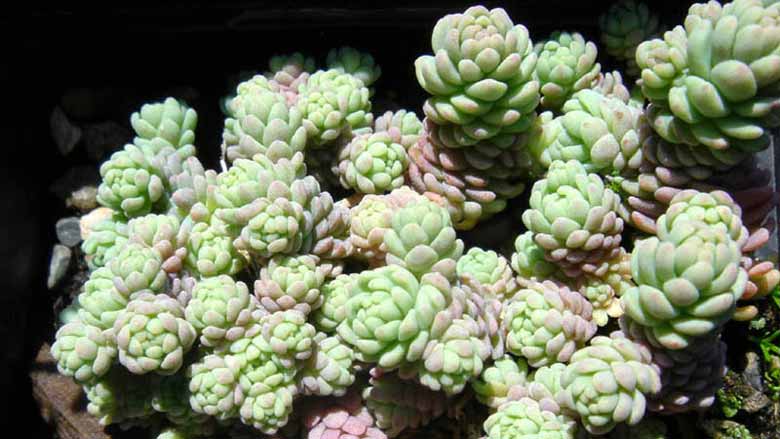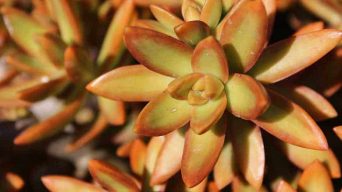The Sedum dasyphyllum, commonly known as Corsican Stonecrop, is a beautiful succulent plant that has become popular in recent years.
This perennial is hardy and can be grown outdoors or indoors.
It’s also easy to propagate, so it’s the perfect plant for beginner gardeners!
In this care guide, you’ll learn everything you need to know about taking care of your Sedum dasyphyllum ‘Corsican Stonecrop’ succulent plants and how to propagate them properly.
Overview
Sedum dasyphyllum is a low-growing flowering plant of the family Crassulaceae and is typical of the Mediterranean region.
The Sedum dasyphyllum is also commonly known as:
- Corsican Stonecrop
- Blue Tears Sedum
- Thick-leaved Stonecrop
- Sedum burnatii
There are two types of succulent plants. Both types are fast growers, though one is much larger than the other.
Sedum dasyphyllum ‘Minor’ is a small succulent with bluish-green and purple thick leaves and creeping stems forming shrubs.
It typically grows up to 3″ to 5″ inches (8 to 13 cm) tall and 8″ – 12″ inches (20 to 30 cm) in diameter.
Sedum dasyphyllum ‘Major’ is a slightly larger mound-forming succulent with bluish-gray leaves. It has stems that creep horizontally with overlapping small and round leaves.
This succulent plant can bloom; you might see them grow white flowers with black dots in the summer.
How To Care for Sedum Dasyphyllum ‘Corsican Stonecrop’
Sedum dasyphyllum care is easy if you know what to do.
The following are the main points to provide proper care for Sedum dasyphyllum ‘Corsican Stonecrop’ succulent plants.
Sun Exposure & Light Requirements
Sedum dasyphyllum ‘Corsican Stonecrop’ can be grown in either full sun or partial shade.
This Sedum succulent needs a lot of sunlight to grow well.
It should be given at least six hours of direct sunlight daily for optimal growth.
It can also do reasonably well in partial shade with some sun exposure during the daytime and bright indirect light or filtered light indoors at night.
Watering Requirements
The Sedum dasyphyllum ‘Corsican Stonecrop’ succulent plant needs to be watered at least once a week.
It should only have water applied when the soil is dry. If it is watered too often, the Sedum will rot and die.
The best time to water the Sedum is in the morning. This will avoid any chance of evening dew, which can be harmful to many succulents.
If you water it at night and want to minimize the risk of rot developing on your Sedum dasyphyllum ‘Corsican Stonecrop’, make sure the Sedum is in a pot with drainage holes.
Soil Requirements
The Sedum dasyphyllum ‘Corsican Stonecrop’ prefers well-draining soil.
A well-draining soil mixture, such as cactus/succulent potting mix, is a good option.
Gravel or sand can be added to equal parts of topsoil for better drainage.
If you are using Sedums for ground cover, they do not need deep pots or large containers because their roots will spread out and take hold of rocks or other surfaces that may be present at your site.
If you sow Sedum seeds directly into the garden area where they will stay permanently exposed outside all year round, use a light potting soil mix so water doesn’t pool around them when watered, which could lead to rot problems later on as they age.
Temperature and Humidity
The sedum dasyphyllum ‘Corsican Stonecrop’ succulent plant does best with a temperature that is between 0° (−18 °C) and 40° Fahrenheit (−18° C and 4° C).
The humidity should be maintained at 40 to 80%.
Fertilizing
The Sedum dasyphyllum ‘Corsican Stonecrop’ does not need much fertilizer but can benefit from a slow-release fertilizer or an occasional dose of general-purpose liquid houseplant food.
The Corsican Stonecrop prefers low but consistent levels of nitrogen to maintain a healthy green coloration.
Apply slow-release fertilizers at half strength every four months during the spring or summer seasons.
Potting and Repotting
When Sedum comes to a point where it needs more room for growth, or the roots are growing out of its container, then you need to repot.
It’s essential to make sure they have proper drainage.
The new pots need to have a hole at least as big as an inch on either side of where you want your Sedum to grow so that excess water can get away from its roots.
Pot size also needs to be larger than the previous pot size when moving Sedum plants into another container or pot- this helps prevent root rot.
As a general rule of thumb, it’s best to move sedum plants up to one pot size every year.
Pruning
Pruning Sedum dasyphyllum plants is paramount to ensuring that they stay healthy and continue growing successfully.
By pruning, it allows them to build strength while removing any dead or diseased stems, branches, leaves, and roots that might be plaguing your plant.
When pruning the Corsican Stonecrop Sedum, cut away any dead or diseased stems and branches at their base.
Be mindful when trimming your Sedums that you do not damage its growing points – these are located on either side of a leaf node where new shoots emerge from older ones.
The most important thing is not to let pruning become an excuse for slowing down in taking care of your plant’s foliage.
Remove only what needs removing while leaving enough leaves so the plant can continue photosynthesizing light and nutrients into food!
Pests and Diseases
Pests and diseases can be a problem for sedum plants like the Sedum dasyphyllum ‘Corsican Stonecrop’.
Some of these pests are aphids, whitefly, mealy bugs, thrips, nematodes, or mites.
These pests will sometimes suck on plant juices resulting in stunted growth and deflated leaves covered with spots of honeydew.
Fungal infections may also occur due to damping off or root rot caused by bacteria such as Pythiumspp., Rhizoctonia solani, Botrytis cinerea, or Sclerotinia sclerotiorum.
The best way to avoid these pests and diseases is by allowing the Sedum plant adequate space, providing a good amount of sunlight (at least six hours per day), keeping the humidity level low, and not overwatering or underwatering it.
How to Care for Sedum Dasyphyllum ‘Corsican Stonecrop’ in Winter
Sedum dasyphyllum ‘Corsican Stonecrop’ is not cold hardy, although it can tolerate moderate frost.
If you live in an area that regularly experiences temperatures below zero degrees Fahrenheit, you should grow this plant in pots that can be brought inside your home during the cold weather.
It’s best to keep them in a sunny location most of the day and away from drafts.
You should also ensure they are watered sparingly during this time not to encourage rot or other problems.
If you want to keep your Sedum in the ground, it’s best to cover it with a thick layer of mulch. This will help insulate the root ball and prevent damage from freezing temperatures.
You should also ensure that sedum plants are not in any standing water if they’re going to spend time outdoors during the winter.
If you follow these tips, your sedum plants will do just fine all through the cold season!
Sedum dasyphyllum ‘Corsican Stonecrop’ will survive the winter outside with protection if you live in a warmer area.
How To Propagate Sedum Dasyphyllum ‘Corsican Stonecrop’
Sedum dasyphyllum ‘Corsican Stonecrop’ can be propagated by stem cuttings and seeds.
Stem Cuttings
Make a clean, vertical incision at the end of an established Sedum plant’s stem cutting and allow it to dry for about 24 hours before planting in potting soil or perlite with sand added.
Place in a bright, sunny area with regular watering and fertilize monthly with a water-soluble fertilizer.
The sedum plant stem cutting will form roots along with the cut, and once it has enough stability to be transplanted without breaking off from the soil, you can transfer it.
Transplant it from its current container to a larger pot. Water liberally and fertilize monthly with a water-soluble fertilizer until the Sedum grows and is healthy enough for outside growth.
Seeds
Seed is the most common way sedums are propagated.
Seedlings will take anywhere from a few weeks to many years before they’re ready for planting out in your garden, depending on how you sow them and where you live.
Seeds require light to germinate, so don’t plant too deep!
Plant seeds shallowly somewhere with plenty of sunlight or use a propagation mat – do not cover them much because Sedum seedlings have fragile leaves that need air circulation to survive.
You can also start Sedum seeds indoors over winter by covering containers with clear plastic bags just loosely enough so they let some air through but still protect against excessive moisture loss.
Sedum succulents grow well from seed, and it’s a good idea to start with some sedum seeds because they are so easy to propagate.
Is the Sedum Dasyphyllum ‘Corsican Stonecrop’ Toxic?
No. The Sedum dasyphyllum ‘Corsican Stonecrop’ plant is not toxic to animals and humans.
However, there is a possibility that the Sedum may cause an allergic reaction in individuals sensitive to succulent plants.
Final Thoughts
Sedum dasyphyllum ‘Corsican Stonecrop’ care is not difficult.
As long as the Sedum is given water and light, it will take care of itself. It does not need much attention, and it doesn’t require much maintenance.
The Corsican Stonecrop is a great sedum for beginners to start with. It is hardy and will survive neglectful care or even being neglected in a pot that’s too small!
This Sedum also makes great cuttings as it grows easily from the stem when correctly propagated, so don’t be afraid to share your plants!







